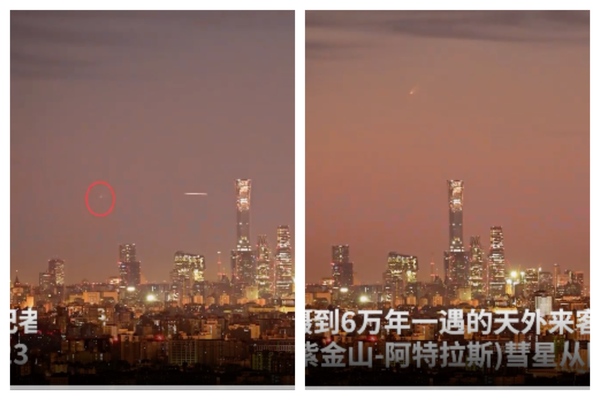On the early morning of October 1st to 2nd, a comet that appears once every sixty thousand years passed over the sky of Beijing, sparking discussions. This comet, known as Comet C/2023 A3 (Zijinshan-Atlas) in official reports, is referred to by the public as the Broom Star, and has historically been seen as an omen of misfortune in both ancient Eastern and Western cultures.
According to a video shared by netizens, the comet was captured sweeping through the sky above Beijing on the early morning of October 1st. The video shows that initially, the comet appeared as a faint halo of light, gradually intensifying until the comet with a trailing tail became clearly visible as it swiftly passed over the Beijing skyline.
On the 2nd, China’s state media CCTV reported that a journalist from the central station captured the rare once-in-sixty-thousand-years visitor from outer space, Comet C/2023 A3 (Zijinshan-Atlas), rising near the China World Trade Center in Beijing. This comet will remain observable until October 10th to 12th.
Comet C/2023 A3 (Zijinshan-Atlas) was discovered by the Purple Mountain Observatory of the Chinese Academy of Sciences in 2023, and its orbital period spans tens of thousands of years.
During the National Day holiday, the once-in-sixty-thousand-years comet’s passage over Beijing has stirred up discussions among the public.
Some internet users remarked, “The comet’s other name is the Broom Star.” “Observing the present can enlighten us about the past; the ancient practice of punishing nine generations of a family does have its reasoning.” “Could this signal a major event to come?” “Once in sixty thousand years, this is quite a spectacle, marking another significant moment in history.” “The appearance of the Broom Star is not a good sign.” “Remember, comets in ancient times symbolized anomalies, indicating changes in destiny.”
Comets, due to their long tail resembling a broom, are also termed as Broom Stars. In Chinese traditional culture, the appearance of comets has always been considered an ominous sign, referred to as a “disaster star” that can bring calamity and death to emperors or male nobility; they are also associated with war, plague, natural disasters, and turmoil.
Ancient Chinese referred to comets as Xingbei, with Dong Zhongshu, a thinker from the Western Han Dynasty, asserting, “Xingbei is born from malevolent qi.”
Liu Xiang, a minister and literary figure from the Western Han Dynasty, said, “The comet, a sinister star, is a sign of chaos and killing.”
The “Book of Han” and “Book of Later Han” recorded numerous instances of the “Xingbei” phenomenon, correlating with disasters, unrest, and assassinations on Earth.
The “Book of Later Han: Astrology” noted that in the third year of Emperor Xiaoming’s Yongping reign (60 AD), a comet passed over the northern part of the Tian Chuan star, moving from north to south and lasting for a hundred and thirty-five days. Tian Chuan symbolizes water, and that year saw floods in Yi and Luo that surged all the way to the gates of Jin City, destroying the Yi Bridge. Seven counties and thirty-two districts suffered major flooding that year.
In the sixth year of the Yonghe period (141 AD), a comet appeared in the eastern sky, passing through military camps, graves, and constellations until reaching the Xuan Yuan constellation before disappearing. The astrology of the time predicted, “The comet rises over military camps and graves; within five years, a great mourning will occur in the world.” Indeed, within five years, the Han Emperor Shundi, Liu Bao, passed away.
According to the “Zuo Zhuan,” in the fourteenth year of Duke Wen of Lu (613 BC), “In the seventh month of autumn, a Xingbei star entered the Northern Dipper. Sushu, the Interior Minister of the Zhou Dynasty, said, ‘Within seven years, the rulers of Song, Qi, and Jin will all perish in chaos.’”.
In ancient beliefs, the Northern Dipper symbolized the image of a great country. When the comet passed over the Northern Dipper, Sushu observed this celestial phenomenon and predicted that within seven years, the rulers of Song, Qi, and Jin would all face death through internal turmoil.
Du Yu’s annotations in the “Zuo Zhuan” confirmed Sushu’s predictions, with the assassinations of the rulers of Song, Qi, and Jin occurring as foreseen. Sushu was a historical figure known for his expertise in astrology and divination.
The “Records of the Grand Historian: Book of Celestial Officials” stated that during the fifteenth year of Emperor Qin Shihuang (210 BC), four comets appeared, with some lasting for eighty days and extending across the sky. Following these celestial events, Emperor Qin Shihuang conquered the six states, expanded his empire, and unified China.
After the fact, the surrounding nations realized that despite their desires to form an alliance against Qin, the inevitable fate of their countries’ downfall could not be escaped.
Comets have not only been considered “disaster stars” in traditional Chinese culture but have also held similar connotations in ancient Western civilizations.
For example, in 1066, Halley’s Comet appeared in England, coinciding with the Norman Conquest of England led by Duke William of Normandy from France. This historical event culminated in the death of King Harold II during the famous Battle of Hastings, leading to William seizing the throne. The fear instilled by the sight of the comet hanging high in the sky was immortalized on the Bayeux Tapestry.
During the return of Comet Halley in 1986, the United States faced the tragedy of the Challenger space shuttle explosion.

